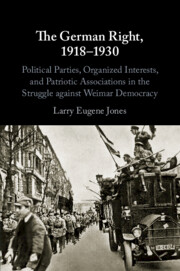 The German Right, 1918–1930
The German Right, 1918–1930 Published online by Cambridge University Press: 21 March 2020
Chapter 9 analyzes Germany’s conservative intelligentsia as it has developed by the middle of the 1920s and the various institutions it has established in pursuit of a young conservative political agenda. Most of the individuals discussed in this chapter – Arthur Moeller van den Bruck, Oswald Spengler, Heinz Brauweiler, Heinrich von Gleichen, and Wilhelm Stapel among others – define themselves as “conservative revolutionaries” who do not to wish to return to the way things were before World War I but who espouse an apocalyptic view of the political and envision a revolutionary transformation of the world in which they live through direct political action. Some like Martin Spahn and Eduard Stadtler are connected to the DNVP, but for the most part they are politically unaffiliated and in most cases opposed to the German party system as it has developed since the founding of the Second Empire. But they are united in a pedagogic mission to educate the younger generation and to instill in it the values and virtues they believe necessary for Germany’s national rebirth.
To save this book to your Kindle, first ensure [email protected] is added to your Approved Personal Document E-mail List under your Personal Document Settings on the Manage Your Content and Devices page of your Amazon account. Then enter the ‘name’ part of your Kindle email address below. Find out more about saving to your Kindle.
Note you can select to save to either the @free.kindle.com or @kindle.com variations. ‘@free.kindle.com’ emails are free but can only be saved to your device when it is connected to wi-fi. ‘@kindle.com’ emails can be delivered even when you are not connected to wi-fi, but note that service fees apply.
Find out more about the Kindle Personal Document Service.
To save content items to your account, please confirm that you agree to abide by our usage policies. If this is the first time you use this feature, you will be asked to authorise Cambridge Core to connect with your account. Find out more about saving content to Dropbox.
To save content items to your account, please confirm that you agree to abide by our usage policies. If this is the first time you use this feature, you will be asked to authorise Cambridge Core to connect with your account. Find out more about saving content to Google Drive.